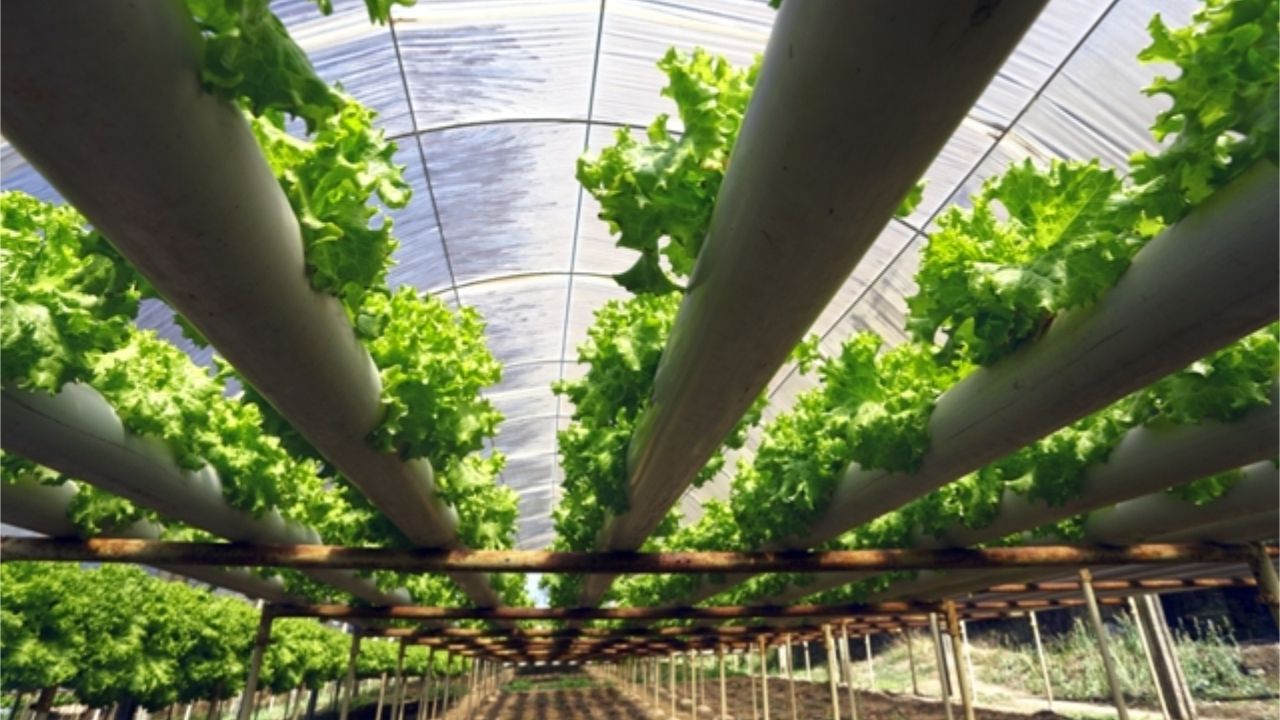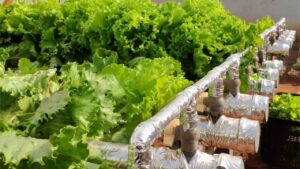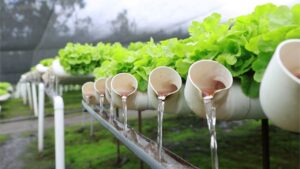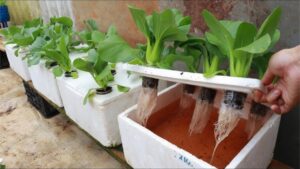Urban hydroponics is an innovative cultivation technique that allows plants to grow without the use of soil, utilizing nutrient solutions instead of dirt. In urban environments, this approach is especially interesting as it maximizes the use of limited spaces, such as rooftops, balconies, and vertical walls, to produce fresh and sustainable food.
In recent years, hydroponics has gained increasing popularity in cities, driven by the search for more eco-friendly and efficient solutions to address the challenges of conventional agriculture, such as limited space and soil degradation. As more people seek alternatives to grow food amidst concrete, hydroponics emerges as a promising response to ensure healthy, locally produced food with a lower environmental impact.
This article aims to explore the main challenges faced by urban hydroponics and present practical solutions to overcome them. By analyzing these obstacles, we seek to provide a helpful guide for those who wish to start or improve a hydroponic garden in cities, promoting sustainability and food autonomy in urban areas.
What is Urban Hydroponics?
Hydroponics is a method of growing plants without the use of soil, replacing it with nutrient solutions that provide all the necessary minerals and compounds for plant growth. Unlike traditional agriculture, where plant roots grow in soil, in hydroponics, they grow directly in water enriched with nutrients. This system allows for more precise control over the growing environment, such as pH, temperature, and humidity, leading to more efficient and healthier production.
The main difference between hydroponics and traditional agriculture lies in the growing medium. While conventional farming relies on soil to support plant roots, hydroponics uses inorganic materials or liquid solutions. This distinction offers several advantages, such as eliminating soil-borne diseases, reducing pesticide use, and enabling cultivation in any environment, such as urban areas where space is limited.
In cities, hydroponics offers several significant advantages. First, it enables the cultivation of fresh, healthy food in locations with little or no available soil, such as rooftops, balconies, or vertical walls. Furthermore, hydroponics is highly water-efficient, as the system recirculates water, using much less than conventional agriculture. Another benefit is the accelerated growth of plants, as they have direct access to essential nutrients, resulting in faster and more abundant harvests. Local food production also reduces the need for transportation and the environmental impact associated with traditional farming in rural areas.
In summary, urban hydroponics not only offers a solution to the lack of space in cities but also contributes to creating a more sustainable and self-sufficient environment. With it, any urban space can be transformed into a productive area, promoting food security and the well-being of people.
Main Challenges of Urban Hydroponics
Although urban hydroponics offers many advantages, it also faces a series of challenges that need to be overcome to ensure successful and sustainable production. Below, we discuss the main obstacles and how they impact cultivation in urban environments.
Limited Space
One of the biggest challenges of urban hydroponics is the lack of suitable space to set up the systems. In cities, available space for cultivation is scarce and often limited to rooftops, balconies, or small plots of land. This limitation can directly affect productivity, as hydroponic systems require enough space to accommodate plants and necessary equipment such as reservoirs and piping. Additionally, the layout of the space can influence system efficiency, such as the necessary solar exposure for optimal plant growth.
High Initial Costs
Setting up a quality hydroponic system requires a considerable initial investment. Equipment such as reservoirs, pumps, tubes, artificial lighting (in some cases), substrates, and sensors to monitor environmental parameters must be purchased. Moreover, automated control systems that regulate nutrient levels and pH can further increase costs. This high initial expense can be a barrier for many people who want to start hydroponics, especially in urban areas where the cost of living is already high.
Lack of Technical Knowledge
Hydroponics, although an efficient technique, requires considerable technical knowledge, which can be a challenge for beginners. To achieve a successful harvest, it’s necessary to understand the specific needs of plants, such as the ideal amount of light, temperature, pH, and nutrients. Without this knowledge, the cultivation may result in low-yield plants or even system failures. The lack of guidance and education on the process is a common obstacle for those starting out in this type of cultivation.
System Maintenance
Maintaining the hydroponic system is essential to ensure its proper functioning and the healthy growth of plants. This includes constant monitoring of nutrient levels, controlling the pH of the nutrient solution, cleaning filters, and preventing blockages in pipes and pumps. Lack of maintenance can lead to issues such as nutrient deficiencies, uneven plant growth, and even system failures, compromising production. Maintenance tasks can be challenging for those who lack experience or do not have the time to care for the system regularly.
Dependence on Electricity
Many hydroponic systems rely on electricity to function properly, especially to pump the nutrient solution through pipes and maintain water circulation. During power outages or electrical failures, plants can suffer damage as they are deprived of adequate nutrition. Dependence on electricity is a challenge, as it can directly affect plant productivity and health. A solution to this involves implementing backup systems or using alternative energy sources, such as solar power, which can increase the system’s initial cost.
Problems with Pests and Diseases
Although hydroponics eliminates many soil-related problems, such as soil-borne diseases, plants grown in hydroponic systems can still be affected by pests and diseases. Lack of proper control can lead to insect infestations or the development of fungi and bacteria. Compared to traditional agriculture, pest control in hydroponics can be more challenging, as conventional methods like pesticide use are not always feasible in closed systems. Biological control and the use of sustainable practices are alternatives, but they require technical knowledge and constant attention.
These challenges may seem daunting, but with proper planning, education, and the use of correct technologies and practices, many of them can be overcome. The next step is to seek practical solutions to ensure that urban hydroponics remains a viable and efficient option.
- See Also: Step-by-Step Guide to Creating a Low-Cost Hydroponic System
- Follow Us: https://www.facebook.com/profile.php?id=61565885846819
How to Overcome the Challenges of Urban Hydroponics
Although the challenges of urban hydroponics are real, there are several practical and innovative solutions that can help overcome them. Below, we discuss some strategies to optimize cultivation and make hydroponics a viable and efficient option in cities.
Utilize Unconventional Spaces
One of the greatest advantages of urban hydroponics is the ability to use unconventional spaces for plant cultivation. Rooftops, vertical walls, terraces, and even recreational areas in buildings can be used to set up hydroponic systems, allowing food to be grown in areas with little or no soil available. Cities around the world, such as New York and Singapore, have excelled at using urban spaces creatively. Successful projects include using rooftops for urban gardens and vertical farming, which help maximize space, reduce soil dependency, and increase local food production.
Invest in Accessible and Scalable Solutions
The high initial cost of hydroponic systems can be a challenge, but there are ways to reduce these costs and make cultivation more accessible. An intelligent approach is to invest in simpler, scalable solutions that can be expanded as the budget and space allow. Using cheaper materials, such as PVC pipes instead of ready-made systems, can be a cost-effective way to start. Additionally, exploring accessible technologies and efficient cultivation methods, such as nutrient film technique (NFT) or deep water culture (DWC) systems, can reduce operational costs and increase productivity without compromising the quality of the crop.
Education and Training
Lack of technical knowledge is one of the biggest obstacles for those wanting to start hydroponics. Investing in education and training is essential to ensure that beginners understand plant needs and how hydroponic systems work. Hydroponic courses and workshops, whether in-person or online, provide a solid foundation for those starting out. Moreover, learning platforms, specialized blogs, and tutorial videos are excellent resources for both beginners and professionals looking to improve their skills.
Technology and Automation
Technology plays a crucial role in optimizing hydroponic systems. Sensors, automated systems, and apps can make maintenance and control of the growing environment much easier. pH, temperature, and humidity sensors help monitor the ideal conditions for plants in real-time, while automated systems regulate irrigation and nutrient dosing, ensuring greater accuracy in management. Some modern systems are fully automated, allowing growers to monitor parameters and make adjustments via an app, making the process more efficient and less prone to human error.
Sustainable Energy Systems
Dependence on electricity can be a limitation in urban hydroponic systems, especially in areas prone to power outages. To make the system more self-sustaining, it is possible to integrate renewable energy sources such as solar power. Using solar panels to power water pumps and other system components can reduce dependence on the grid and make cultivation more independent and eco-friendly. Additionally, using batteries or backup generators can ensure the continuity of cultivation even during power failures.
Biological Control and Sustainable Practices
Controlling pests and diseases in hydroponic systems requires different practices than those used in traditional agriculture. Since the use of pesticides can be harmful in closed systems, natural pest control methods, such as biological control, are more suitable. This involves introducing beneficial organisms, such as predatory insects or microorganisms, that control pests in a sustainable way. Additionally, integrating sustainable agricultural practices, such as composting or using organic fertilizers, can improve the system’s health and reduce the need for chemical inputs. These approaches not only help protect the environment but also improve the quality and safety of the food produced.
With these solutions, it is possible to overcome the main challenges of urban hydroponics, creating a more efficient, accessible, and sustainable growing environment. By adopting these practices, urban growers can ensure the success of their hydroponic projects and contribute to a greener, more self-sufficient future in cities.
Success Stories in Urban Hydroponics
Several cities around the world have demonstrated how it is possible to overcome the challenges of urban hydroponics, creating innovative initiatives that promote local food production in a sustainable way. Below, we highlight some successful examples that are inspiring other cities to adopt hydroponics as a viable solution for urban food security.
Singapore: “Sky Greens” and the Future of Vertical Farming
Singapore, a city-state known for its lack of natural resources, has stood out as a global leader in urban agricultural innovation. A successful example is the “Sky Greens” project, a vertical farm that uses hydroponics to grow fresh vegetables in greenhouses mounted on steel structures. This system allows for the maximization of limited urban space, as plants grow in multiple vertical layers, using little water and energy. The project not only provides fresh food to the local population but also serves as a model for other cities looking for solutions to the scarcity of arable land.
New York: “Brooklyn Grange” and Local Production on Rooftops
In New York, Brooklyn Grange is one of the largest urban hydroponic and organic farms on rooftops. With over 4 acres of cultivated space, this initiative uses hydroponics to grow fresh vegetables and herbs in an area where soil is virtually nonexistent. The project not only solves the space issue but also offers solutions for reducing food transportation, decreasing the carbon footprint. Brooklyn Grange has become an example of how large cities can integrate innovative agricultural practices with a direct impact on urban quality of life and access to fresh food.
Los Angeles: “The Farm LA” and Sustainability in the Heart of the City
In Los Angeles, the “The Farm LA” project is an example of how hydroponics can be used in urban environments to promote sustainability and food security. Located in a limited urban space, the project uses hydroponic systems and sustainable agricultural practices to grow a variety of crops, from lettuce to fruits. The use of solar energy to power the system and the application of cutting-edge technologies to monitor optimal growing conditions are examples of how technology can be effectively used to make hydroponics more accessible and self-sustaining.
Amsterdam: “Urban Greenhouse” and Collaboration Between Businesses and Government
Amsterdam stands out with the “Urban Greenhouse” project, a collaboration between businesses, the government, and universities to create a hydroponic growing system in the city center. The project aims not only to provide fresh, local food for the population but also to reduce dependence on food transportation and improve urban air quality. The use of advanced technology and the integration of sustainable practices, such as solar energy capture, make this initiative a global reference for how hydroponics can be efficiently applied in a modern city.
Tokyo: “Hydroponic Roof Farming” and the Challenge of Limited Space
In Tokyo, where urban space is extremely limited, the “Hydroponic Roof Farming” project utilizes rooftops of commercial buildings to grow food. These projects not only help reduce the pressure on conventional agriculture but also improve the quality of life in cities by providing fresh food directly to local communities. The use of technologies such as automated irrigation and solar energy makes the cultivation process sustainable and efficient, without relying on large amounts of space or natural resources.
How These Projects Are Inspiring Other Cities
These success stories are inspiring many other cities to adopt hydroponics as a viable solution to urban challenges. The ability to grow fresh food in limited urban spaces, reduce carbon footprints, and promote sustainability is a strategy that is gaining increasing traction. Additionally, these projects demonstrate that with the right use of technology and innovation, it is possible to overcome challenges such as limited space, resource scarcity, and the need for healthy food in densely populated urban areas.
As more cities around the world begin to explore hydroponics as a viable alternative, it is expected that these successful examples will multiply, creating a global network of urban initiatives that help transform cities into more sustainable and self-sufficient environments.
Conclusion
However, we also discussed a range of practical solutions to overcome these obstacles, such as utilizing unconventional spaces like rooftops and vertical walls, investing in accessible and scalable systems, promoting education and training, incorporating technology and automation, integrating sustainable energy sources, and adopting biological control methods for pest management.
Looking ahead, the future of urban hydroponics appears promising. As cities continue to grow and face challenges related to food security and environmental sustainability, hydroponics provides a viable solution to produce fresh, local food in limited spaces. By embracing innovation and sustainable practices, urban hydroponics has the potential to revolutionize food production in cities, reducing dependency on traditional agriculture and making cities more self-sufficient and resilient.
We encourage you to explore more about this exciting topic and consider how hydroponics could be implemented in your own urban space. Whether you’re an aspiring grower, a city planner, or simply someone interested in sustainable living, hydroponics offers a wealth of opportunities to contribute to the future of urban food systems. The potential for creating greener, healthier cities starts with informed and passionate individuals like you.




